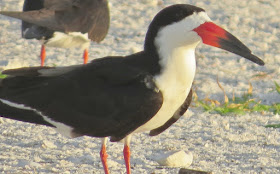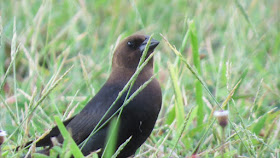Thursday May 2nd
Today had to be at the docks in Key West by 7:30 to board the
Yankee Freedom for the 70 mile sail to
Dry Tortugas National Park and
Fort Jefferson. On the long drive down the Keys in the pre-dawn, I was able find a calling
Antillean Nighthawk in Tavernier.
 |
| A look at Fort Jefferson |
 |
| Fort Jefferson |
The waters were calm and the skies were clear as the Yankee Freedom approached the Tortugas. With a pass by Hospital Key we could see the only nesting colony of Masked Boobies within the United States. And as we came up the Garden Key and the huge Fort Jefferson structure, the skies were filled with Magnificent Frigatebirds, Sooty Terns and Brown Noddies. These four species use these isolated islands as their only nesting sites within the continental United States.
Thousands of Sooty Terns and Brown Noddies are currently nesting on nearby Bush Key. These birds, plus the expectation of finding birds in spring migration taking a rest at the fort are why birders from around the world visit these islands. They come on the ferry, on private tours and by seaplane.
 |
In 2014 the Coast Guard Cutter Sawfish
had collected Cuban
refugees that had land in the Tortugas,
|
Fort Jefferson or to just enjoy the beach. I set about looking for interesting birds. There were a few migrating species om hand including Yellow-billed Cuckoo, Gray Kingbird, Cape May, Black-and-White, Black-throated Blue and American Redstart Warblers. A Purple Gallinule had also somehow managed to reach the Garden Key. Bridled Terns, Brown Noddies and Frigatebirds were relatively easy to photograph, but the Sooties tended to be more challenging.
I didn't snorkel, but the waters were tempting. By walking the moat, observations of various fishes are possible. Like tarpon, grunts, bluehead wrasses, beaugregory damselfish, sergeant majors, rainbow parrotfish, purple sea fans and more reef life.
It got too hot for me so I escaped early to the air-conditioning aboard the boat. By 3:30 we were on the return leg back to Key West. A trio of juvenile Northern Gannets flew with boat for a bit about an hour from reaching port.
 |
| Magnificent Frigatebird |
 |
| Bridled Terns |
 |
| Brown Noddies |
 |
| The water was so clear |
 |
| Brown Noddy |
Had a enough time left in the day, after returning to Key West, to check-out the birding at
Fort Zachary Taylor SP. Lots of
Cape May Warblers and American Redstarts, plus Black-and White, Black-throated Blue, Magnolia and Northern Parula, Got good looks at
White-crowned Pigeon, Least tTrns, Frigatebirds, Gray Kingbird, Green Iguanas and Curly-tailed Lizards.
 |
| White-crowned Pigeon |
 |
| Cape May Warbler |
 |
| Northern Paula |















































